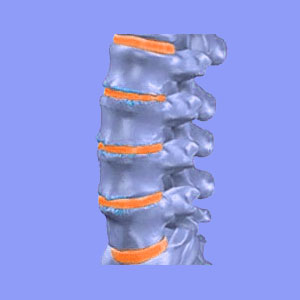
Degenerative disc disease is a condition which is sometimes blamed for causing or contributing to sciatica, especially in the absence of more notable and potentially serious spinal abnormalities. DDD is the ultimate spinal scapegoat, since it is universal and is always a reliable standby when there is no other more logical reason for the symptoms to occur.
Unfortunately, implicating disc deterioration as the cause of sciatica is usually ridiculous. In fact, in all but the very worst instances, disc degeneration is no cause for alarm and certainly is no source of chronic pain.
This essay investigates degenerative disc disease changes in the lumbar spine and how these may or may not be involved in a sciatic nerve expression.
Degenerative Disc Disease Defined
DDD is certainly not a disease at all. It is merely one of the medical terms for the completely normal and expected spinal aging process which affects the intervertebral discs. I have long campaigned for this name to no longer be used in diagnostics, since it is frightening to the patient and mistaken in its terminology. Disc dessication is a much better and more accurate name.
The nomenclature of disc disease is very damaging and a prime factor in the diagnostic nocebo effect suffered by every patient. However, most people do not know that disc degeneration is simply an unavoidable and generally asymptomatic part of getting older.
The disc degeneration process is especially noticeable in the lumbar and cervical spinal regions, where the majority of people experience mild to moderate degenerative changes by the age of 30. Many people see these same changes far younger. For detailed information on disc degeneration, please research the comprehensive degenerative disc disease section at Herniated-Disc-Pain.Org.
DDD Facts
Here are some real facts of disc dessication which may help to dispell many of the myths associated with the diagnosis:
DDD can be blamed for sciatica, lower back pain and cervical pain.
DDD will never get better, since it is a progressive process.
DDD is rarely seriously symptomatic, if at all.
DDD begins about age 20 in most people.
The most common location for DDD is L4/5 and L5/S1.
DDD makes herniations more likely, but less symptomatic.
DDD is often found in conjunction with spinal osteoarthritis.There is virtually no reliable clinical evidence of any pathological process demonstrated in even severe cases of DDD. Sure, losing disc height will bring the vertebral bones closer to one another, narrow the foraminal spaces and incite the arthritic process. However, these are all completely normal to experience in the lower back and evolution has prepared our spines to experience these changes universally as we age.
I have seen patients with intractable and debilitating pain being diagnosed with very mild disc degeneration as the causation, without any verifiable evidence that the deteriorated discs play any part in the symptoms. I have also seen patients who literally have no discs left in multiple areas of the lumbar spine. Their degeneration is extreme, yet they have no pain and never have. These examples also reflect widely cited research results in many studies and this is why most major medical associations have warned doctors never to diagnose any atypical disc abnormality as the source of pain without definitive evidence of such. Unfortunately, it seems that many doctors have turned a deaf ear to these recommendations in order to increase profitability.
Degenerative Disc Disease Guidance
I talk to patients every day who have been diagnosed with DDD as their main dorsopathy complaint. This is unacceptable to even consider upon seeing the MRI results, since their degenerative changes are no different than any other I have seen and typically far less than my own.
Degenerative disc disease can exist in very extreme forms, but this is very, very rare. Even normal, but severe cases of disc degeneration are not typically problematic. Most DDD is simply an excuse for explaining back pain conditions which have not be accurately diagnosed, due to inability or economical motivation.
I was diagnosed with DDD by my first chiropractor at the tender age of 16. The way this guy explained the condition to me, I thought the world was ending. Speaking of a significant nocebo effect. He definitely laid the framework for my house of pain (a house which was continually built by many care providers from a number of healing arts). I was devastated to hear that my spine was in such poor shape at such a young age and it certainly does not surprise me that my pain worsened year by year until it virtually controlled my life.
DDD is not the usual source of any pain or suffering. It is certainly not the typical cause of serious or chronic sciatica pain. DDD is simply a normal part of aging.
The medical professionals hold on to a few examples of aberrant disc degeneration as proof that this condition can be problematic. In these truly extreme cases, they might be correct. However, these patients are like finding a needle in a haystack, while the rest of us who have been diagnosed might as well have heard this: “Ok, Mr. Jones, I have diagnosed your sciatica. It is due to your gray hair. It also might be due to some of those tiny wrinkles around your eyes. You are not getting any younger”.
This diagnosis is no more ridiculous than blaming severe chronic sciatica on normal and expected disc degeneration.





